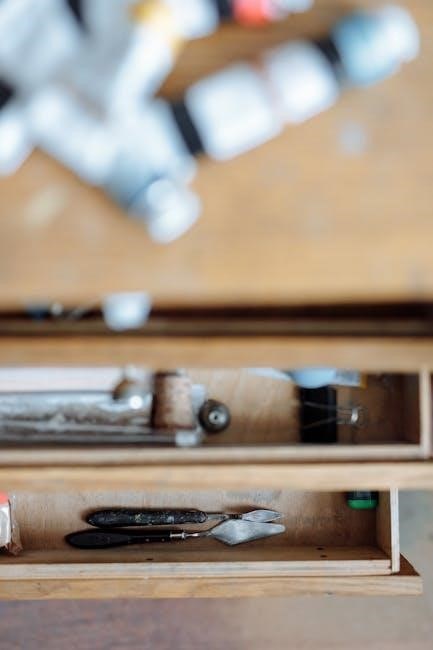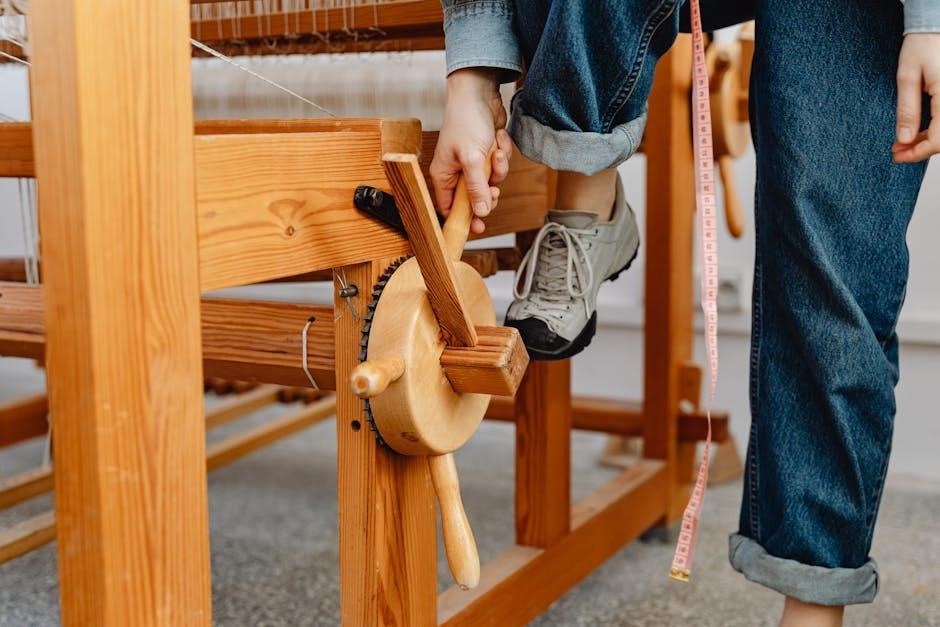An ice maker manual is a comprehensive guide providing essential information on installation, operation, and maintenance. It ensures safe and efficient use of the appliance, covering various models like portable, undercounter, and nugget ice makers. Manuals also highlight key features, troubleshooting tips, and warranty details to optimize performance and longevity.
Overview of Ice Maker Functionality
An ice maker automates the process of creating ice, offering convenience and efficiency. It freezes water, shapes it into ice, and harvests it once frozen. Portable and undercounter models are popular, with nugget and flake ice makers catering to specific needs. Modern units feature continuous cycles, smart sensors, and energy-saving modes. Proper water supply, drainage, and ventilation ensure optimal performance, making them versatile for home, commercial, or outdoor use. Regular maintenance is key to longevity and consistent ice production.
Importance of Reading the Manual
Reading the ice maker manual ensures safe and efficient operation. It provides essential safety guidelines, installation requirements, and maintenance tips. Understanding the manual helps troubleshoot issues, optimize performance, and extend the product’s lifespan. It also explains how to use advanced features and address common problems. Following the manual prevents damage and ensures compliance with manufacturer recommendations, enhancing overall functionality and user satisfaction.

Safety Guidelines for Ice Maker Usage
Always follow electrical safety precautions and ensure proper ventilation. Avoid overheating and keep the unit away from water sources. Use genuine parts for repairs.
Electrical Safety Precautions
Ensure your ice maker is plugged into a grounded electrical outlet to prevent shocks. Avoid using extension cords, as they may cause fire hazards. Keep the power cord away from water to prevent electrical damage. Never operate the unit with damaged cords or plugs, and avoid overloading circuits. Always unplug the ice maker before cleaning or servicing. Consult the manual for specific electrical requirements to ensure safe operation.
Proper Placement and Ventilation
Place your ice maker on a stable, level surface to ensure proper operation. Maintain at least 4 inches of clearance on all sides for adequate airflow. Avoid direct sunlight or heat sources, as this can affect performance. Ensure the area is well-ventilated to prevent heat buildup. For built-in models, follow specific installation guidelines to meet ventilation requirements. Proper placement ensures efficiency and longevity of your ice maker.
Preparing the Ice Maker for First Use
Before first use, rinse the interior with warm water to remove any manufacturing residue. Ensure the water supply is connected securely, but avoid over-tightening. Plug in the ice maker and allow it to cool down for 24 hours before producing ice. Run a few cycles without collecting ice to ensure proper function. This preparation ensures clean and efficient ice production from the start.

Types of Ice Makers
Ice makers vary by design, including portable, undercounter, countertop, nugget, and flake models, each catering to different needs and spaces for convenient ice production.
Portable Ice Makers
Portable ice makers are compact, self-contained units designed for easy mobility and use in small spaces. They don’t require installation and can produce ice quickly, often in under 10 minutes. Ideal for RVs, boats, or outdoor events, these units feature automatic shut-off and adjustable ice size settings. Their compact design and energy efficiency make them a popular choice for temporary or supplemental ice needs in various settings.
Undercounter Ice Makers
Undercounter ice makers are built-in appliances designed to fit seamlessly into kitchen cabinetry, offering a sleek, integrated look. They require professional installation and a dedicated water supply line. These units are ideal for high-capacity ice production, perfect for large households or commercial settings. They often feature advanced controls, silent operation, and energy-efficient designs. Regular maintenance, including cleaning and filter replacements, ensures optimal performance and longevity.
Nugget Ice Makers
Nugget ice makers, also known as Sonic Ice Makers, are popular for producing small, chewable ice nuggets ideal for households and small businesses. They feature a compact design and a closed-loop system that recycles water to minimize waste. These units are energy-efficient and operate quietly. Regular cleaning and filter replacements are essential for maintaining performance and hygiene. Nugget ice makers offer a convenient and durable solution for ice production.
Flake Ice Makers
Flake ice makers produce thin, flexible ice flakes ideal for cooling displays, seafood, and medical applications. They use a vertical evaporator to freeze water into a thin layer, which is then scraped off to form flakes. These units are highly efficient and often feature durable construction. Regular maintenance, such as cleaning and drainage checks, ensures optimal performance and longevity. Flake ice makers are versatile and widely used in commercial settings.
Countertop Ice Makers
Countertop ice makers are compact, portable units designed for personal or small-scale use. They are ideal for homes, RVs, or offices due to their space-saving design. These units typically use a self-contained system, requiring only water and power to operate. Many models offer quick ice production, low noise levels, and adjustable settings. Regular cleaning and descaling are essential to maintain performance and extend lifespan, ensuring consistent ice production.

Installation Requirements
Ensure the ice maker is placed in a well-ventilated area, leveled properly, and connected to a water supply. Plan for drainage and nearby electrical access.
Choosing the Right Location
Select a location with proximity to a water supply and drainage. Ensure good ventilation to prevent moisture buildup. Avoid direct sunlight and heat sources for consistent performance. Place on a level surface and near electrical outlets. Keep away from walls to allow proper airflow. Ensure the location is easily accessible for maintenance and cleaning. Consider the space for ice storage and usage convenience.
Leveling the Ice Maker
Ensure the ice maker is placed on a level surface using a spirit level. If the surface isn’t level, adjust the feet or use shims to stabilize it. Check that the machine doesn’t wobble and all feet are firmly on the ground. Proper leveling ensures even ice production and prevents vibration. Refer to the manual for specific leveling recommendations to guarantee optimal performance and longevity of the appliance.
Connecting the Water Supply
To connect the water supply, locate the water inlet valve, typically found at the back or bottom of the ice maker. Attach the provided water supply line to both the valve and your water source. Ensure all connections are secure to prevent leaks. Turn on the water supply slowly and check for leaks. Once connected, plug in the ice maker and allow it to start producing ice. Regularly inspect the line for wear and replace if necessary.

Key Features of Modern Ice Makers
Modern ice makers offer advanced features like high-efficiency compressors, touchscreen controls, and customizable ice settings, ensuring convenient and energy-saving operation for various needs and preferences.
Automatic Ice Making Cycles
Modern ice makers feature automatic ice making cycles, enabling hands-free operation. Sensors detect water levels and ice storage, automating the process from filling to freezing. This ensures consistent ice production without manual intervention, while adaptive controls optimize efficiency and reduce waste. Automatic cycles also include timers and shut-off features, preventing overfilling and ensuring maintenance is minimal. This technology enhances convenience, making ice production seamless and reliable for users.
Smart Controls and Sensors
Smart controls and sensors in modern ice makers enhance functionality and efficiency. Touchscreen interfaces and mobile app connectivity allow users to monitor and adjust settings remotely. Sensors detect ice levels, water supply, and temperature, optimizing performance and preventing overfilling. Advanced models include self-diagnostic features, alerting users to maintenance needs or issues. These technologies ensure precise control, energy savings, and a seamless user experience, making ice production efficient and convenient.
Energy Efficiency Features
Modern ice makers often include energy-saving technologies to reduce power consumption. Features like Energy Star certification ensure efficient operation. Some models have eco-mode settings to minimize energy use during off-peak times. Adaptive sensors adjust cooling cycles based on demand, while smart compressors optimize performance. LED indicators remind users to maintain optimal conditions. These features help lower energy bills and environmental impact, making the appliance more sustainable and cost-effective for long-term use.
Optional Accessories
Optional accessories can enhance your ice maker’s functionality. Water filters improve ice quality and taste, while ice scoops and storage buckets provide convenient ice management. Some models offer stands or carts for mobility. Drainage pumps are useful for units without a built-in drain. Custom ice molds allow for unique shapes. Additional accessories may include cleaning kits or replacement parts. Always check compatibility with your specific ice maker model for optimal performance.

Maintenance and Cleaning
Regularly clean the ice maker’s exterior with a soft cloth and mild detergent. Descaling every 3-6 months prevents mineral buildup. Check and clean the ice ejector and water inlet. Lubricate moving parts if recommended. Always unplug the unit before cleaning to ensure safety and prevent damage.
Regular Cleaning Procedures
Regular cleaning ensures optimal performance and prevents bacteria growth. Turn off and unplug the ice maker before cleaning; Wipe the exterior with a damp cloth and mild detergent. Remove and wash the ice bin and water reservoir with warm soapy water. Dry all parts thoroughly to prevent water spots. Clean the ice chute and dispenser regularly to avoid mineral buildup. Always refer to the manual for specific cleaning recommendations.
Replacing the Water Filter
Replace the water filter every 6 months or as indicated by the manual. Turn off the water supply and locate the filter, usually near the water inlet. Remove the old filter by turning it counterclockwise. Install the new filter, ensuring it clicks securely. Flush the system by running 2-3 gallons of water through the ice maker to remove any impurities. Refer to the manual for specific replacement guidelines.
Defrosting and Drainage
Regular defrosting ensures efficient operation and prevents ice buildup. Turn off the ice maker, remove excess ice, and let it thaw naturally; For drainage, position the drain hose securely or use a drain pan. After defrosting, clean the drain to prevent clogs. Check the manual for specific defrosting intervals, typically every 3–6 months, depending on usage. Always unplug the unit before defrosting to ensure safety.

Troubleshooting Common Issues
Identify symptoms, check the manual for solutions, and contact support if issues persist. Regular maintenance often resolves common problems.
Ice Maker Not Producing Ice
If your ice maker isn’t producing ice, check the power connection and ensure it’s turned on. Verify the water supply line is not kinked or frozen. Ensure the ice maker switch is activated and the water valve is fully open. If issues persist, check for blockages in the ice chute or refer to the manual’s troubleshooting section for specific guidance. If unresolved, contact customer support.
Ice Quality Issues
If your ice maker produces low-quality ice, ensure the water filter is clean or replaced regularly. Check for impurities in the water supply and adjust settings for cube size or freezing time. Verify that the water temperature is within the recommended range. Descaling may be necessary if mineral buildup affects ice clarity. Refer to your manual for specific maintenance recommendations to resolve ice quality issues effectively.
Strange Noises or Leaks
If your ice maker produces unusual noises or leaks, inspect the water supply lines for loose connections or damage. Check the drain for blockages and ensure the unit is properly leveled. Loud noises may indicate worn or malfunctioning internal components like the fan or compressor. Addressing leaks promptly can prevent water damage. Consult your manual for troubleshooting steps or contact customer support for professional assistance if issues persist.
Understanding Error Codes
Error codes on your ice maker indicate specific issues, helping you identify and resolve problems quickly. Refer to your manual for a list of codes and their meanings, such as temperature sensor malfunctions or water supply errors. Addressing these codes promptly ensures optimal performance and prevents further damage. If unresolved, contact customer support for professional assistance to diagnose and repair the issue effectively.

Operating the Ice Maker
Start by turning on the ice maker and selecting your desired settings. Monitor production, adjust size or speed as needed, and ensure water supply is stable for smooth operation.

Starting the Ice Maker
To start the ice maker, ensure it is properly plugged in and placed on a stable surface. Turn on the power switch, usually located on the control panel. Select the desired ice size or mode using the buttons or dial provided. Allow the machine to complete its initial cycle, which may take a few minutes. You’ll hear operational sounds as it begins producing ice. Always refer to the manual for specific startup instructions. Ensure the water supply is connected if required. After starting, monitor the ice production to ensure it’s functioning correctly. If issues arise, consult the troubleshooting section. Proper startup ensures optimal performance and longevity of the appliance. Always follow the manufacturer’s guidelines for initial operation. This helps prevent any potential damage and ensures safety. Regular checks before starting can also help maintain efficiency. Remember to store ice promptly to keep it from melting. Starting the ice maker correctly sets the foundation for reliable ice production. Adjust settings as needed for different ice-making requirements. Proper initialization ensures all features work seamlessly. Familiarize yourself with the control panel to customize settings. Starting the ice maker is straightforward, but attention to detail ensures smooth operation. Always ensure the ice maker is clean before starting to avoid contamination. This step is crucial for maintaining hygiene and ice quality. Proper startup also helps in reducing energy consumption. By following the manual’s instructions, you can ensure the ice maker runs efficiently from the start. Regular maintenance after startup is also recommended. This includes checking water filters and drainage systems. A well-maintained ice maker will perform better and last longer. Starting the ice maker is just the beginning of enjoying fresh, clean ice whenever you need it. Always prioritize safety and efficiency when operating your ice maker. Following the manual’s startup guide ensures a safe and effective experience. Proper operation from the start helps in preventing issues down the line. Enjoy the convenience of fresh ice with a well-operated ice maker. Starting the ice maker is a simple process that, when done correctly, ensures years of reliable service. Always refer to the manual for any specific startup requirements unique to your model. This ensures you get the most out of your appliance. Starting the ice maker is the first step toward enjoying its benefits. Make sure to follow all instructions carefully. Proper startup ensures safety, efficiency, and quality ice production. This initial step is crucial for the overall performance of the ice maker. Always prioritize proper startup procedures for optimal results. Starting the ice maker correctly is essential for its functionality and longevity. Follow the manual’s guidance to ensure everything works as intended. This initial step sets the stage for consistent ice production. Proper startup helps in avoiding unnecessary repairs and maintenance. By following the manual, you can ensure your ice maker starts and runs smoothly. Starting the ice maker is a straightforward process that requires attention to detail. Always ensure all prerequisites are met before turning it on. This ensures safe and efficient operation. Proper startup is the foundation of trouble-free ice making. Follow the manual’s instructions to get the best performance from your ice maker. Starting the ice maker is the beginning of a convenient ice-making experience. Always start with a clean and well-maintained appliance for the best results. Proper startup ensures your ice maker operates at its full potential. This step is vital for enjoying fresh ice whenever you need it. Starting the ice maker is simple when you follow the manual’s guidelines. Ensure all safety precautions are taken before initializing the appliance. This ensures a safe and efficient experience. Proper startup is key to unlocking your ice maker’s full capabilities. Always refer to the manual for specific instructions tailored to your model. Starting the ice maker is an easy process that, when done right, ensures years of reliable service. Make sure to follow all startup procedures carefully. Proper initialization ensures your ice maker runs smoothly and produces high-quality ice. This step is essential for maintaining the appliance’s performance. Starting the ice maker correctly is the first step toward enjoying its benefits. Always follow the manual’s startup guide for optimal results. Proper operation from the start ensures safety, efficiency, and quality. This initial step is crucial for the overall functionality of the ice maker. Starting the ice maker is a simple yet important process. Follow the manual’s instructions to ensure everything works as intended. Proper startup helps in preventing issues and ensures longevity. Always prioritize correct initialization for the best performance. Starting the ice maker is the beginning of a convenient and reliable ice-making experience. Follow the manual’s guidance to ensure smooth operation. Proper startup ensures your ice maker meets your needs effectively. This step is vital for enjoying fresh ice whenever you need it. Starting the ice maker is straightforward when you follow the provided instructions. Ensure all prerequisites are met for safe and efficient operation. Proper startup is essential for the ice maker’s performance and longevity. Always refer to the manual for specific startup requirements. Starting the ice maker correctly ensures optimal performance and prevents potential issues. Follow the manual’s startup guide for a safe and efficient experience. Proper initialization is crucial for enjoying the benefits of your ice maker. Starting the ice maker is a simple process that requires attention to detail. Always follow the manual’s instructions for the best results. Proper startup ensures your ice maker operates efficiently and produces high-quality ice. This step is essential for maintaining its performance. Starting the ice maker is the first step toward enjoying its convenience. Follow the manual’s guidance to ensure smooth operation. Proper startup ensures safety, efficiency, and quality ice production. This initial step is crucial for the overall functionality of the ice maker. Starting the ice maker is a straightforward process when you follow the manual’s instructions. Ensure all safety precautions are taken before initializing the appliance. Proper startup is key to unlocking your ice maker’s full potential. Always refer to the manual for specific startup procedures tailored to your model. Starting the ice maker correctly ensures reliable performance and longevity. Follow the manual’s startup guide for optimal results. Proper operation from the start ensures your ice maker meets your needs effectively. This step is vital for enjoying fresh ice whenever you need it. Starting the ice maker is simple when you follow the provided instructions. Ensure all prerequisites are met for safe and efficient operation. Proper startup is essential for the ice maker’s functionality and longevity. Always prioritize correct initialization for the best performance. Starting the ice maker is the beginning of a convenient and reliable ice-making experience. Follow the manual’s guidance to ensure smooth operation. Proper startup ensures your ice maker operates at its full potential. This step is crucial for maintaining its performance. Starting the ice maker correctly is the first step toward enjoying its benefits. Always refer to the manual for specific startup requirements. Proper startup ensures safety, efficiency, and quality ice production. This initial step is vital for the overall functionality of the ice maker. Starting the ice maker is a simple process that, when done correctly, ensures years of reliable service. Follow the manual’s instructions to get the best performance from your appliance. Proper startup is the foundation of trouble-free ice making. Always ensure all safety precautions are taken before initializing the ice maker. This ensures a safe and efficient experience. Starting the ice maker is the beginning of a convenient ice-making experience. Always start with a clean and well-maintained appliance for the best results.
Adjusting Settings
To adjust settings on your ice maker, locate the control panel, typically found on the front or top. Use the buttons or touchscreen to navigate through options like ice size, production speed, or timer functions. Some models offer smart features for customizing ice-making cycles. Ensure the unit is powered on before making adjustments. Save your preferences if the model allows it. Always refer to the manual for specific guidance tailored to your ice maker’s features. Adjusting settings optimizes performance and ensures the ice meets your needs. Follow the manual’s instructions for precise adjustments to avoid errors. Proper setting adjustments enhance efficiency and ice quality. Experiment with settings to find your preferred configuration. Adjusting settings is straightforward once familiar with the control panel layout. Regularly reviewing and adjusting settings ensures consistent ice production. Use the manual as a reference for troubleshooting or resetting default settings if needed. Adjusting settings allows you to personalize your ice-making experience. Ensure all changes are saved to maintain your preferences for future use. Adjusting settings is a convenient way to tailor the ice maker’s operation to your lifestyle. Always follow the manufacturer’s guidelines for adjusting settings to avoid damaging the appliance; Proper adjustments ensure the ice maker operates efficiently and meets your expectations. Adjusting settings is a key part of customizing your ice-making experience. Refer to the manual for detailed instructions on how to adjust settings for optimal performance. Adjusting settings allows you to fine-tune the ice maker’s functionality to suit your needs. Always save your settings after adjustments to ensure they are applied. Adjusting settings is a simple process that enhances the overall performance of the ice maker. Use the control panel to explore and adjust settings as needed. Adjusting settings ensures your ice maker operates at its best. Follow the manual’s guidance for making adjustments safely and effectively. Adjusting settings is a convenient feature that allows you to customize ice production. Ensure all adjustments are made while the ice maker is in operation. Adjusting settings helps in maintaining consistent ice quality and quantity. Always refer to the manual for specific instructions on adjusting settings for your model. Adjusting settings is a straightforward process that enhances your ice-making experience. Use the control panel to adjust settings and optimize performance. Adjusting settings ensures your ice maker meets your specific needs. Follow the manual’s instructions for adjusting settings to ensure proper functionality. Adjusting settings is a key feature that allows you to personalize your ice maker’s operation. Always save your settings after making adjustments. Adjusting settings is a simple way to improve the efficiency and output of your ice maker. Refer to the manual for guidance on adjusting settings for optimal results. Adjusting settings ensures your ice maker operates smoothly and efficiently. Use the control panel to adjust settings and customize ice production. Adjusting settings is a convenient way to tailor the ice maker’s performance to your preferences. Always follow the manual’s instructions for adjusting settings. Adjusting settings allows you to optimize the ice maker’s functionality for your needs. Ensure all adjustments are made correctly to avoid operational issues. Adjusting settings is a straightforward process that enhances the overall performance of the ice maker. Refer to the manual for specific guidance on adjusting settings for your model. Adjusting settings ensures your ice maker produces ice that meets your expectations. Use the control panel to adjust settings and customize the ice-making process. Adjusting settings is a simple yet effective way to enhance your ice-making experience. Always refer to the manual for instructions on adjusting settings. Adjusting settings allows you to fine-tune the ice maker’s operation for optimal performance. Ensure all adjustments are saved to maintain your preferences. Adjusting settings is a convenient feature that allows you to personalize your ice maker’s functionality. Follow the manual’s guidelines for adjusting settings to ensure safety and efficiency. Adjusting settings is a key part of maintaining consistent ice production. Use the control panel to adjust settings and optimize performance. Adjusting settings ensures your ice maker operates at its best. Refer to the manual for detailed instructions on adjusting settings for your specific model. Adjusting settings is a simple process that allows you to customize the ice maker’s operation. Always follow the manual’s guidance for making adjustments. Adjusting settings ensures your ice maker meets your needs effectively. Use the control panel to adjust settings and enhance performance. Adjusting settings is a straightforward way to improve the efficiency and output of your ice maker. Refer to the manual for specific instructions on adjusting settings. Adjusting settings allows you to optimize the ice maker’s functionality for your lifestyle. Ensure all adjustments are made correctly to avoid issues. Adjusting settings is a convenient feature that enhances the overall performance of the ice maker. Always refer to the manual for guidance on adjusting settings. Adjusting settings is a simple yet important process for customizing your ice maker’s operation. Use the control panel to adjust settings and optimize ice production. Adjusting settings ensures your ice maker operates smoothly and efficiently. Follow the manual’s instructions for adjusting settings to ensure proper functionality. Adjusting settings allows you to personalize the ice maker’s performance to your preferences. Ensure all adjustments are saved to maintain your settings. Adjusting settings is a key feature that enhances the ice maker’s functionality. Refer to the manual for specific guidance on adjusting settings for your model. Adjusting settings ensures your ice maker produces high-quality ice consistently. Use the control panel to adjust settings and customize the ice-making process. Adjusting settings is a simple way to improve the efficiency and output of your ice maker. Always follow the manual’s instructions for adjusting settings. Adjusting settings allows you to fine-tune the ice maker’s operation for optimal performance. Ensure all adjustments are made correctly to avoid operational issues. Adjusting settings is a straightforward process that enhances the overall performance of the ice maker. Refer to the manual for detailed instructions on adjusting settings for your specific model. Adjusting settings ensures your ice maker operates at its best. Use the control panel to adjust settings and optimize performance. Adjusting settings is a convenient way to tailor the ice maker’s functionality to your needs. Always refer to the manual for guidance on adjusting settings. Adjusting settings allows you to customize the ice maker’s operation for your lifestyle. Ensure all adjustments are saved to maintain your preferences. Adjusting settings is a key part of maintaining consistent ice production. Follow the manual’s instructions for adjusting settings to ensure safety and efficiency. Adjusting settings ensures your ice maker meets your expectations for ice quality and quantity. Use the control panel to adjust settings and enhance performance. Adjusting settings is a simple process that allows you to personalize the ice maker’s functionality. Refer to the manual for specific guidance on adjusting settings for your model. Adjusting settings ensures your ice maker operates smoothly and efficiently. Always follow the manual’s instructions for adjusting settings. Adjusting settings allows you to optimize the ice maker’s operation for your needs. Ensure all adjustments are made correctly to avoid issues. Adjusting settings is a convenient feature that enhances the overall performance of the ice maker. Use the control panel to adjust settings and customize ice production. Adjusting settings ensures your ice maker produces ice that meets your preferences. Refer to the manual for detailed instructions on adjusting settings. Adjusting settings is a straightforward process that improves the efficiency and output of your ice maker. Always refer to the manual for specific guidance on adjusting settings. Adjusting settings allows you to fine-tune the ice maker’s functionality for optimal performance. Ensure all adjustments are saved to maintain your settings. Adjusting settings is a key feature that enhances the

Resources for Further Assistance
Monitoring Ice Production
Regularly monitor the ice production to ensure optimal performance. Check the ice basket to avoid overflow and maintain efficiency. Refer to the manual for specific guidance on monitoring features. Most ice makers have indicators or alarms to signal when the basket is full or if issues arise. Ensure the machine has enough water and proper drainage. Monitoring helps prevent overfilling and ensures consistent ice quality. Adjust production settings as needed based on usage patterns. Always follow the manual’s recommendations for monitoring and maintaining your ice maker. Regular checks ensure smooth operation and extend the appliance’s lifespan. Monitor ice production to meet your needs effectively. Adjust settings as needed to maintain performance. Ensure the ice maker is functioning correctly by monitoring its output regularly. Refer to the manual for troubleshooting if production slows or stops. Monitoring ice production helps identify potential issues early, ensuring continuous ice supply. Adjust settings as needed to optimize performance. Regular monitoring ensures the ice maker operates efficiently and meets your expectations. Always follow the manual’s guidance for monitoring and maintaining your appliance. Monitoring ice production is essential for maintaining efficiency and ice quality. Refer to the manual for specific instructions on monitoring your ice maker. Regular monitoring helps prevent issues and ensures consistent performance. Adjust settings as needed to optimize ice production. Always follow the manual’s recommendations for monitoring and maintaining your ice maker. Monitoring ice production ensures the appliance operates smoothly and meets your needs. Regular checks help identify and address potential issues early. Adjust settings as needed to maintain optimal performance. Refer to the manual for guidance on monitoring your ice maker. Monitoring ice production is a key part of maintaining your appliance’s efficiency and longevity. Always follow the manual’s instructions for monitoring and adjusting settings as needed. Monitoring ensures consistent ice quality and prevents operational issues. Adjust settings as needed to optimize performance. Refer to the manual for specific guidance on monitoring your ice maker. Regular monitoring helps maintain efficiency and extends the lifespan of your appliance. Adjust settings as needed to ensure optimal performance. Always follow the manual’s recommendations for monitoring ice production. Monitoring helps identify and address potential issues early, ensuring smooth operation. Refer to the manual for specific instructions on monitoring your ice maker. Regular monitoring ensures consistent ice quality and prevents overflow. Adjust settings as needed to optimize performance. Always follow the manual’s guidance for monitoring and maintaining your ice maker. Monitoring ice production is essential for maintaining efficiency and extending the appliance’s lifespan. Refer to the manual for specific instructions on monitoring and adjusting settings. Regular monitoring helps ensure the ice maker operates smoothly and meets your needs. Adjust settings as needed to maintain optimal performance. Always follow the manual’s recommendations for monitoring ice production. Monitoring ensures consistent ice quality and prevents operational issues. Refer to the manual for guidance on monitoring your ice maker. Regular checks help identify potential problems early, ensuring continuous ice supply. Adjust settings as needed to optimize performance. Always follow the manual’s instructions for monitoring and maintaining your appliance. Monitoring ice production is a key part of maintaining efficiency and ice quality. Refer to the manual for specific guidance on monitoring and adjusting settings. Regular monitoring ensures smooth operation and extends the lifespan of your ice maker. Adjust settings as needed to maintain optimal performance. Always follow the manual’s recommendations for monitoring ice production. Monitoring helps prevent issues and ensures consistent performance. Refer to the manual for specific instructions on monitoring your ice maker. Regular checks ensure the appliance operates efficiently and meets your needs. Adjust settings as needed to optimize ice production. Always follow the manual’s guidance for monitoring and maintaining your ice maker. Monitoring ice production is essential for maintaining efficiency and extending the appliance’s lifespan. Refer to the manual for specific instructions on monitoring and adjusting settings. Regular monitoring helps ensure consistent ice quality and prevents overflow. Adjust settings as needed to maintain optimal performance. Always follow the manual’s recommendations for monitoring ice production. Monitoring ensures smooth operation and helps identify potential issues early. Refer to the manual for guidance on monitoring your ice maker. Regular checks ensure the appliance operates efficiently and meets your expectations. Adjust settings as needed to optimize performance. Always follow the manual’s instructions for monitoring and maintaining your ice maker. Monitoring ice production is a key part of maintaining efficiency and ice quality. Refer to the manual for specific guidance on monitoring and adjusting settings. Regular monitoring ensures the ice maker operates smoothly and consistently. Adjust settings as needed to maintain optimal performance. Always follow the manual’s recommendations for monitoring ice production. Monitoring helps prevent issues and ensures continuous ice supply. Refer to the manual for specific instructions on monitoring your ice maker. Regular checks ensure the appliance operates efficiently and meets your needs. Adjust settings as needed to optimize performance. Always follow the manual’s guidance for monitoring and maintaining your ice maker. Monitoring ice production is essential for maintaining efficiency and extending the lifespan of your appliance; Refer to the manual for specific instructions on monitoring and adjusting settings. Regular monitoring helps ensure consistent ice quality and prevents operational issues. Adjust settings as needed to maintain optimal performance. Always follow the manual’s recommendations for monitoring ice production. Monitoring ensures smooth operation and helps identify potential problems early. Refer to the manual for guidance on monitoring your ice maker. Regular checks ensure the appliance operates efficiently and meets your expectations. Adjust settings as needed to optimize performance. Always follow the manual’s instructions for monitoring and maintaining your ice maker. Monitoring ice production is a key part of maintaining efficiency and ice quality. Refer to the manual for specific guidance on monitoring and adjusting settings. Regular monitoring ensures the ice maker operates smoothly and consistently. Adjust settings as needed to maintain optimal performance. Always follow the manual’s recommendations for monitoring ice production. Monitoring helps prevent issues and ensures continuous ice supply. Refer to the manual for specific instructions on monitoring your ice maker. Regular checks ensure the appliance operates efficiently and meets your needs. Adjust settings as needed to optimize performance. Always follow the manual’s guidance for monitoring and maintaining your ice maker. Monitoring ice production is essential for maintaining efficiency and extending the lifespan of your appliance. Refer to the manual for specific instructions on monitoring and adjusting settings. Regular monitoring helps ensure consistent ice quality and prevents overflow. Adjust settings as needed to maintain optimal performance. Always follow the manual’s recommendations for monitoring ice production. Monitoring ensures smooth operation and helps identify potential issues early. Refer to the manual for guidance on monitoring your ice maker. Regular checks ensure the appliance operates efficiently and meets your expectations. Adjust settings as needed to optimize performance. Always follow the manual’s instructions for monitoring and maintaining your ice maker. Monitoring ice production is a key part of maintaining efficiency and ice quality. Refer to the manual for specific guidance on monitoring and adjusting settings. Regular monitoring ensures the ice maker operates smoothly and consistently. Adjust settings as needed to maintain optimal performance. Always follow the manual’s recommendations for monitoring ice production. Monitoring helps prevent issues and ensures continuous ice supply. Refer to the manual for specific instructions on monitoring your ice maker. Regular checks ensure the appliance operates efficiently and meets your needs. Adjust settings as needed to optimize performance. Always follow the manual’s guidance for monitoring and maintaining your ice maker. Monitoring ice production is essential for maintaining efficiency and extending the lifespan of your appliance. Refer to the manual for specific instructions on monitoring and adjusting settings. Regular monitoring helps ensure consistent ice quality and prevents operational issues. Adjust settings as needed to maintain optimal performance. Always follow the manual’s recommendations for monitoring ice production. Monitoring ensures smooth operation and helps identify potential problems early. Refer to the manual for guidance on monitoring your ice maker. Regular checks ensure the appliance operates efficiently and meets your expectations. Adjust settings as needed to optimize performance. Always follow the manual’s instructions for monitoring and maintaining your ice maker. Monitoring ice production is a key part of maintaining efficiency and ice quality. Refer to the manual for specific guidance on monitoring and adjusting settings. Regular monitoring ensures the ice maker operates smoothly and consistently. Adjust settings as needed to maintain optimal performance. Always follow the manual’s recommendations for monitoring ice production. Monitoring helps prevent issues and ensures continuous ice supply. Refer to the manual for specific instructions on monitoring your ice maker. Regular checks ensure the appliance operates efficiently and meets your needs. Adjust settings as needed to optimize performance. Always follow the manual’s guidance for monitoring and maintaining your ice maker. Monitoring ice production is essential for maintaining efficiency and extending the lifespan of your appliance. Refer to the manual for specific instructions on monitoring and adjusting settings. Regular monitoring helps ensure consistent ice quality and prevents overflow. Adjust settings as needed to maintain optimal performance. Always follow the manual’s recommendations for monitoring ice production. Monitoring ensures smooth operation and helps identify potential issues early. Refer to the manual for guidance on monitoring your ice maker. Regular checks ensure the appliance operates efficiently and meets your expectations. Adjust settings as needed



